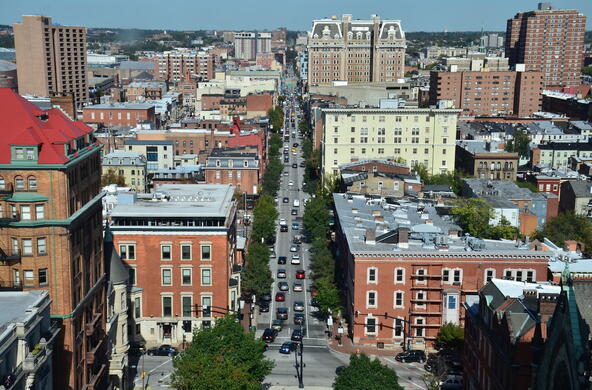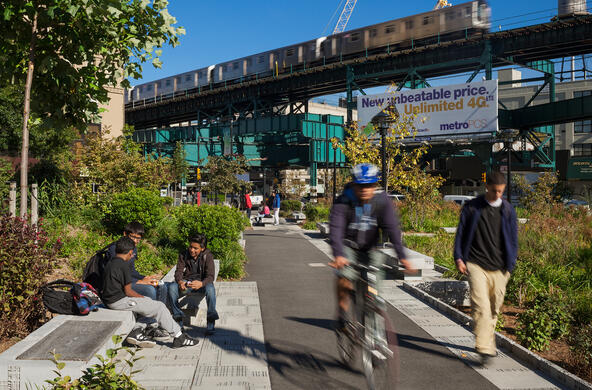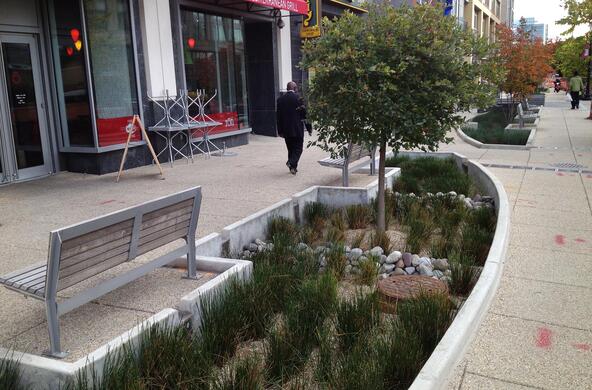In Butchers Hill, one of Baltimore’s more affluent neighborhoods, a small patch of nature stands out in a landscape dominated by brick rowhouses, asphalt roads and other hard surfaces. The colorful sign planted in the soft earth identifies this corner of the intersection of East Lombard and South Chester streets as a “rain garden.”
The city government, nonprofit groups and private developers have invested millions of dollars for the construction of hundreds of these and similar types of nature-mimicking projects over the past two decades. The primary purpose of this “green” infrastructure is to capture and soak up polluted stormwater runoff before it flows into the Inner Harbor and Chesapeake Bay.
It can also spruce up a neighborhood, said Amanda Phillips de Lucas, a Baltimore-based social scientist, as she knelt over the winter-brown plants in the Butchers Hill nook. “There’s not a lot of trash,” she observed, “so they’re taking care of it.”
Green stormwater infrastructure has long been cast as a win-win in big cities. But a recent line of research suggests that underprivileged communities are far less likely to see it. And a new study that exclusively examines Baltimore’s efforts finds that the Charm City isn’t immune.
More than half of the 712 green projects documented inside the city were installed by developers, who were required to do so to offset the environmental impacts of new building projects. In those cases, the study found that green infrastructure was nearly twice as likely to land in white neighborhoods.
Development-related green infrastructure projects were rare even in Black neighborhoods with higher incomes, the authors said.
Green infrastructure projects that were not related to development were typically constructed voluntarily by city workers or nonprofit groups. Those efforts were largely centered in neighborhoods whose populations were either wealthy and white or poor and Black, the analysis revealed.
“That just reflects two prongs of the way nonprofits operate,” said Joanna Solins, the study’s lead author and a University of California-Davis environmental horticulture adviser. “Some are really focused on trying to provide benefits for low-income and underprivileged communities. And some are focused on helping community groups and schools do these [green projects] themselves, and those projects tend to be in the whiter, wealthier areas.”
But the voluntary projects in under-privileged neighborhoods were relatively few and small in scope, the study found.
The paper was part of the long-running Baltimore Ecosystem Study and published in January in the journal Landscape and Urban Planning. The other partners in the research were the University of California-Davis and the U.S. Forest Service.
Their efforts produced the most comprehensive database of green stormwater projects in the city, enabling the researchers to categorize them by location.
Struggling to adapt
Interviews conducted by the Bay Journal with the study’s authors, local environmental leaders and the former head of Baltimore’s stormwater division portray a greening effort with well-meaning intentions but spotty execution. (A media relations representative with the city’s Department of Public Works said she was looking into possible interviews with current stormwater personnel but didn’t respond to follow-up messages.)
More than 45% of Baltimore’s landscape is covered by pavement, rooftops or other impervious surfaces where rainfall cannot penetrate the ground. Decades of stormwater research suggest that water quality is considered severely degraded when impervious coverage is greater than 25%.
The city is crisscrossed by more than 100 miles of streams, but historically there were many more waterways. Development in the 1800s and early 1900s filled in and paved over many of them. They were replaced by a jumbled network of storm drains and pipes designed to capture rainfall and quickly shunt it to remaining waterways to prevent flooding. Much of that infrastructure is outdated and rapidly deteriorating.
When they began to be adopted in earnest across the country in the 1990s, green stormwater projects presented a promising solution. In addition to treating stormwater by allowing it to filter into the ground, greening the landscape could, among other benefits, provide recreation spaces and lower temperatures in asphalt-ridden “heat islands.”
But the rollout in Baltimore has been uneven, the sources said. The biggest obstacles included haphazard planning that has deepened pre-existing neighborhood inequities, poor coordination with community members and a dearth of funding for maintaining projects beyond the first couple of years.
These flaws often have implications for environmental justice.
For example, development-related green projects, which tend to occur more often in white neighborhoods, must be inspected to ensure proper maintenance every three years. There is no such requirement for voluntary projects.
Many of the voluntary projects are built with grant money. Some get funding to cover maintenance for the first year or so. But anything longer than that is rare. It usually falls to overextended nonprofits or individuals in the community to manage their upkeep.
As a result, voluntary projects are much more prone to failure, said de Lucas, a co-author of the study and researcher with the New York-based Cary Institute of Ecosystem Studies.
“A lot of places we had a location for, we’d get out and it was a dirt field,” de Lucas said.
The study authors, citing a growing body of environmental scholarship, say that Baltimore’s inequities aren’t unique. For instance, a separate study published in 2017 found similar disparities in Philadelphia, with Black and low-income neighborhoods receiving the short end of the green infrastructure stick.
Another analysis, which examined planning documents in 19 cities, showed that environmental justice was rarely factored into green infrastructure projects, accounting for barely 2% of the siting criteria language. Baltimore was among a handful of cities that explicitly incorporated the philosophy, though. One of the factors to consider in prioritizing a project, according to the city’s 2015 stormwater plan, is its “potential to address environmental justice.”
Still, the results of the latest Baltimore Ecosystem Study suggest that there remains a disconnect between the city’s plans and its actions, said Fushcia-Ann Hoover, the lead author of the planning-document study and a professor at the University of North Carolina-Charlotte.
“There is not as much alignment between the particular equity criteria when it comes to the actual planning at the site scale, where things are actually being placed,” she said. Hoover, who was not involved in the Baltimore Ecosystem Study, added that she was particularly struck by the finding that disparities persisted even in Black neighborhoods with higher incomes.
De Lucas cautioned that many community members and a sizeable number of experts don’t necessarily view such projects as “inherently a good thing.”
If the projects thrive, they can contribute to a neighborhood’s gentrification, putting economic stress on lower-income families, critics say. And if the projects are poorly maintained and fail — a result in about 25% of cases, according to a separate citywide assessment — they can become eyesores.
“It can empower one set of people while disempowering another set of people,” de Lucas said.
Fairness put into action
The racial disparity in green stormwater amenities would be far more glaring in the new study, the authors say, if not for a particularly large project constructed in the 2000s across nearly a dozen neighborhoods in west and southwest Baltimore.
Called the Watershed 263 project, it sought to inject nature into one of the city’s most urbanized sectors, said Bill Stack, who oversaw Baltimore’s stormwater management program at the time. No streams existed within the drainage area — just a hodgepodge of storm drains all leading to a single outlet, spewing untreated runoff into the Middle Branch of the Patapsco River.
As Stack saw it, here was an area where he could make an ecological and socio-logical difference.
“I wanted to focus on more of the inner city and the more disadvantaged neighborhoods that were more disconnected from the streams,” said Stack, now a senior adviser to the nonprofit Center for Watershed Protection. “It just seemed to be unfair to focus our restoration efforts on the parts of the city that had flowing streams where those people could take advantage of them.”
Stack enlisted the help of community members and a local group, the Parks and People Foundation of Baltimore, and began rolling out projects across the 930-acre project area. Participants planted trees, transformed vacant lots into verdant sanctuaries, removed asphalt from schoolyards and installed green infrastructure to absorb wayward rainwater.
From an environmental standpoint, the consensus is that water quality improved. But experts say it’s unclear how much of that improvement was attributable to Watershed 263 or instead to separate efforts underway at that time, such as the repair of a long-running sewage leak.
“One of the lessons of that is it’s very difficult to measure the influence of green stormwater infrastructure on nutrients,” Solins said.
Today, Watershed 263 is sometimes viewed as a cautionary tale. Steven Preston, a parks design manager with Parks and People, said organizers at the time should have worked harder to put community members at the center of the effort to help ensure stronger support for the project in the long term.
“When we put those practices in, we were only thinking about stormwater stuff, and they kind of sit in isolation,” he said. “That was a good teachable moment to us on a better way to do it, which is incorporating them into a larger green space plan.”
Watershed 263 was the city’s first foray into green stormwater, Stack said. Missteps were almost inevitable. But future generations of planners and designers can learn from them, he added.
“When we would go to the community meetings, even though we had a lot of support, there was a lot of talk about [how] we’re trying to improve the environment, [when] the real issues are jobs, crime and education,” Stack recalled. “There are other benefits that go beyond water quality, and in all good conscience I feel strongly that the investment to improve water quality has to be holistic and be associated with other benefits.”
The work ahead
The Baltimore Ecosystem Study researchers point out that their database isn’t as complete as they would like it to be. To simplify the analysis, they excluded tree-planting efforts and stream restoration projects because they often cross neighborhood boundaries. Because of the lag time between the data collection and publication, the projects are updated only to 2019.
By its own account, the city has a large workload.
According to Baltimore’s 2015 watershed implementation plan for the Chesapeake Bay, officials face a goal of treating stormwater runoff from 20% of the city’s eligible impervious cover. That equates to nearly 4,300 acres of land. At the time of the plan’s adoption, only slightly more than 350 acres of the city’s jurisdiction qualified as properly treated.
To meet that new pollution reduction goal, the plan largely relies on a stepped-up street cleaning program. But it has identified dozens of potential targets for green stormwater retrofits, mainly consisting of stream restoration projects, tree plantings and the creation of small, park-like additions to streetscapes, like those in Butchers Hill.
Progress has been sluggish. According to the latest project tracking report, which was published by the city in 2021, 10 of the 85 projects have been completed.






